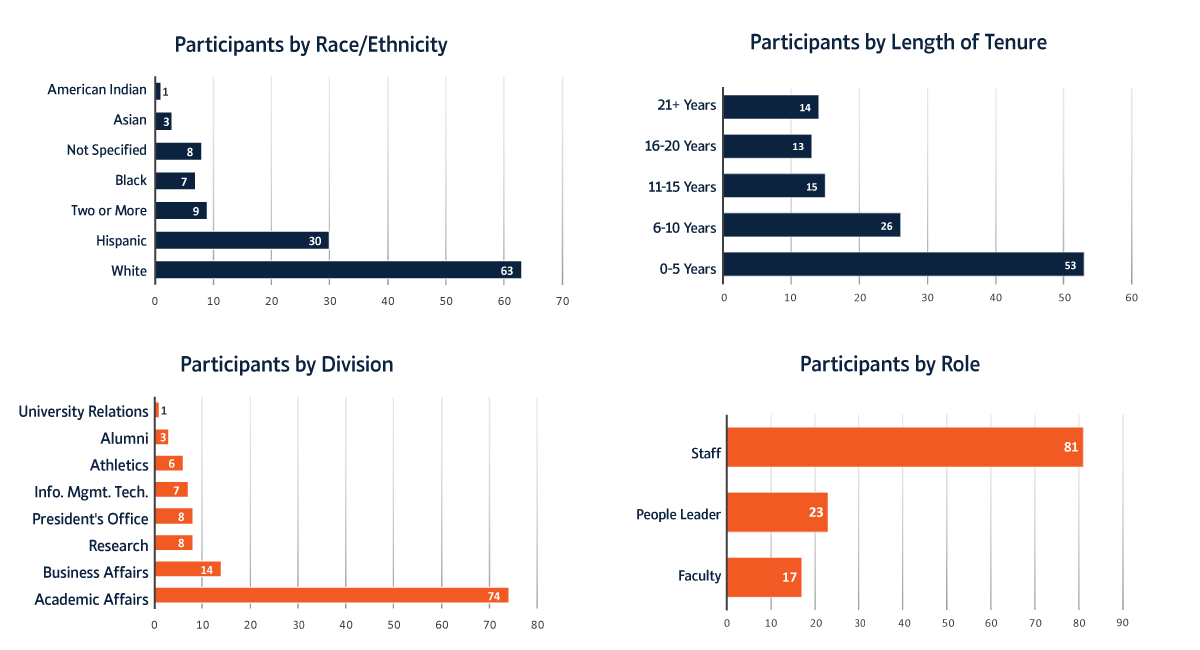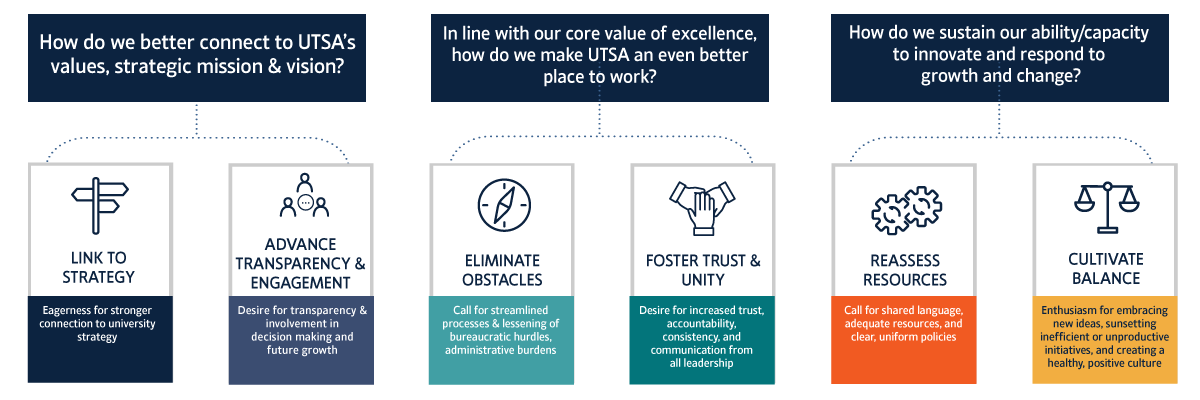Faculty & Staff Campus Climate

The university is dedicated to making positive and significant changes in response to the Faculty and Staff Campus Climate Survey. Your voices are, and continue to be, essential.
Our Process
Results of the university's first faculty and staff campus climate survey were shared with the campus community in fall 2021. The results offer a glimpse into our university’s strengths and areas for growth, and they enable us to focus on the future.
To gather more insight, People Excellence hosted a series of conversations at the institutional and divisional level in spring 2022, allowing us to hear directly from our faculty and staff. Now, we invite you to explore our process, as well as the themes, recommendations and action plans that were developed as a result of these conversations.
Institutional Approach
Institutional focus groups were held in April 2022 in partnership with Huron, who facilitated discussions. These focus groups explored three interconnected themes that emerged from the results of the Faculty and Staff Campus Climate Survey.

Institutional focus groups were designed to reflect the population of the university community. Learn more below.

Divisional Approach
At the divisional level, individual meetings with leaders and Human Resource Business Partners (HRBPs) also took place in April. Additional feedback was gathered from teams through focus groups, listening sessions and pulse surveys. Over 250 employees participated in focus groups led by the HRBPs, and we received 545 responses to pulse surveys. An overview of the number of divisional areas throughout the university is below.
| Executive Area | Divisional Areas |
|---|---|
| Academic Affairs | 20 |
| Advancement & Alumni Engagement | 1 |
| Athletics | 1 |
| Business Affairs | 7 |
| President's Division | 1 |
| Research and Economic Development | 1 |
| University Relations | 1 |
| University Technology Solutions | 1 |
Themes and Recommendations
A variety of themes emerged from the institutional focus groups, providing key considerations for the university to consider as it develops plans to move forward.
From these overarching themes, we developed the six priority areas of focus shown below. The campus community will receive updates as these strategies are implemented.
LINK TO STRATEGY
Strategic Plan Refresh & Integration
Increase and enhance employee engagement through strategic and growth initiatives.
FOSTER TRUST & UNITY
Educate About Current Services
Provide regular formal communication about existing university services that benefit employees.
ADVANCE TRANSPARENCY & ENGAGEMENT
University “All Hands” Gatherings
Provide routine updates from university leadership through campus-wide events, to include opportunities to ask questions or provide feedback.
CULTIVATE BALANCE
Benchmark Impactful Policies & Procedures
Develop and communicate policies that will positively impact employee success and retention.
REASSESS RESOURCES
Assessment of Current Resources
Conduct a comprehensive assessment and benchmarking of staffing levels, roles, responsibilities and compensation across all university areas.
ELIMINATE OBSTACLES
Centralize Employee Resources
Establish a centralized, accessible online employee hub to access information.
Action Plans
With the valuable feedback provided through our survey and focus groups, each area of the university was asked to create an action plan to outline their path forward. These plans address the results and feedback from divisional areas, allowing each area to ensure its action plan is customized to support the unique and varying needs from team to team.
When developing plans, areas were asked to directly address communications needs, as well as their individual survey results. From these action plans, the topics below emerged as common themes across the university.
| Cascading Communication: Establish new forums for interaction, such as town halls, check-ins, new regular meetings, brown bag lunches, and more. | Continuous Feedback: Create opportunities to continue gathering input and feedback through additional engagement and focus groups. | ||
| Transparency in Decision-Making: Create more transparent divisional processes for strategic planning, decision making and budgeting. | Rewards and Recognition: Develop opportunities for faculty and staff recognition. | ||
| Professional Development: Create opportunities for professional development, include career pathways, job description refinement, leadership training, competency-based training and team building. | Compensation: Continue to review staffing and compensation levels. | ||
Explore Action Plans
Academic Affairs & Provost
This area also incorporates plans for Academic Strategic Communications and Institutional Research.
Areas of focus:
- Team connection and continuous engagement
- Improve communications
- Create a sense of belonging
Academic Innovation
Areas of focus:
- Shared governance; policies, resources and efficiency
- Respect and appreciation
Academic Success
Areas of focus:
- Improve change management and organizational communication
- Improve employee recognition efforts
- Support staff in understanding career advancement opportunities
Administration and Operations
Areas of focus:
- Foster Better Communication
- Build Trust
- Expand Employee Recognition Efforts
- Provide Additional Professional Development Opportunities
Advancement and Alumni Engagement
Areas of focus:
- Strengthen communication
- Strengthen team collaboration
- Strengthen respect and appreciation
- Boost accountability, fairness and transparency
Alvarez College of Business
Areas of focus:
- Improve communication of issues of importance, especially changes that impact faculty and staff
- Improve two-way communication between faculty/staff and leadership team
- Explore solutions to concerns about faculty/staff workload and understanding
Athletics
Areas of focus:
- Facilities
- Staff and coaches are meaningfully involved in departmental planning and communication
- Professional development
- Rewards/recognition and connectedness
Campus Services
Areas of focus:
- Improve communication
- Recognition
College of Education and Human Development
Areas of focus:
- Increasing staff engagement in COEHD governance and decision making
- Building transparency with faculty in COEHD operations
- Optimize Student Success Center and form COEHD Student Advisory Council
College of Liberal and Fine Arts
Areas of focus:
- Improve communication accessibility and transparency
- Review compensation for staff
- Improve collaboration, culture, encouragement, fairness and teamwork
- Review facilities, resources and efficiency constraints
College of Sciences
Areas of focus:
- Communication
- Recognition
- Compensation
Facilities
Areas of focus:
- Communication
- Work environment
- Wages and staffing
Financial Affairs
Areas of focus:
- Direction and focus
- Listening to team feedback
- Professional development
- Shared governance in institutional planning
- Awards and recognition
Global Initiatives
Areas of focus:
- Improve recognition
- Improve team building
- Improve communication
Graduate and Postdoctoral Studies (Graduate School)
Areas of focus:
- Guide team through change to acceptance of new organizational structure by focusing on communication, collaboration and professional development
Health, Community and Policy (HCAP)
Areas of focus:
- Mental health
- Strategic planning/communication
- Communication/shared governance
Honors College
Areas of focus:
- Regularly review workload alignment with priorities
- Improve communication – Honors College priorities and outcomes
Klesse College of Engineering and Integrated Design
Areas of focus:
- Improve trust in all leadership
- Promote and empower faculty and staff roles in shared governance, management and programs
- Identify resources provided to schools and departments, as well as gaps between needed and provided resources
- Expand and emphasize community and industry outreach, pathways and access
Libraries
Areas of focus:
- Improve change management and communications
- Retain excellent and diverse staff
- Improve governance and clarity around decision making
- Improve sense of camaraderie and teamwork
President’s Division
Areas of focus:
- Assess needs and align divisional plans with the Strategic Destinations
- Build division identity and promote meaningful employee engagement
- Enhance trust and transparency through improved communication
Public Safety
Areas of focus:
- Communication
- Employee engagement
- Employee wellbeing
Real Estate, Construction and Planning
Areas of focus:
- Communication
- Process refinement
- Employee development
- Collaboration
Research and Economic Development
Areas of focus:
- REDKE staff satisfaction survey
- Organizational communications
- Staff engagement
- Professional development
- Staff compensation
School of Data Science
No action plan.
Strategic Enrollment
Areas of focus:
- Improve communication
- Review staffing and turnover
- Develop recognition program
- Expand professional development opportunities
Student Affairs
Areas of focus:
- Improve communication
- Focus on collaboration, encouragement and teamwork. Job satisfaction, pride, and professional development.
- Review culture and fairness. Compensation.
- Evaluate leadership. Facilities, resource and efficiency constraints.
- Develop a greater focus on work/life balance.
Student Success
Areas of focus:
- Review compensation
- Improve communication
- Expand professional development opportunities
University College
Areas of focus:
- Improve faculty onboarding process
- Help employees understand promotion-related policies and practices
- Create more opportunities to provide appropriate and meaningful recognition
- Continue to enhance college-level communications
University Relations
Areas of focus:
- Improve communication and recognition
- Analyze allocation of resources
- Develop consistent project management protocols
- Encourage and support work/life balance
- Establish continuous communication/information sharing processes
- Evaluate status of vacant positions and staffing
- Create professional development opportunities
University Technology Solutions
Areas of focus:
- Improve communication
- Develop more teamwork and group work
- Involve staff more in strategic planning and project planning
- Address staffing shortages, promotions, adjusting job duties, and lower pay
- Provide more management and leadership development, as well as professional development.
